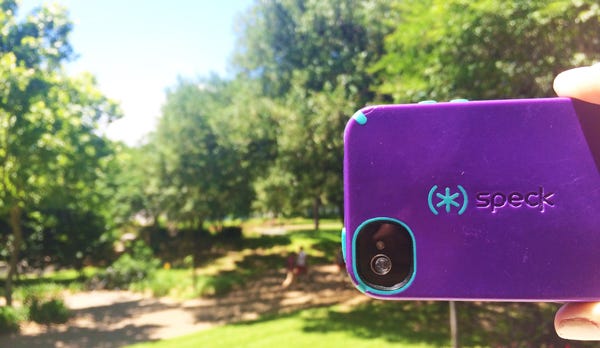This Is How You Turn Your Smartphone Into a Microscope
May 7, 2015
Researchers create an optical lens that can be attached to virtually any smartphone to amplify images by a magnitude of 120, for just 3 cents a lens.
Kristopher Sturgis
|
The microscope lens, shown here attached to a smartphone, would only cost 3 cents to produce in bulk. (Image courtesy of the University of Houston) |
These days, turning smartphones into useful alternative devices is far from a novel idea,. From collecting and measuring DNA samples, to measuring cell counts and possibly detecting cancer, cell phones have been transformed into devices that can do so much more than simply answer calls and texts. Now, they can even be used as a makeshift microscope through a simple attachment to the smartphone's camera.
Researchers from the University of Houston (UH) have created an optical lens that can be placed on almost any inexpensive smartphone with a camera, to amplify images by a magnitude of 120, all for just three cents per lens, according to a university news release.
Researchers developed the lens to operate as a microscope intended for those who work in resource-limited areas, as well as for students who may not be able to afford traditional high-cost microscopes. The lens attaches directly to a smartphone camera lens, without the need for any additional devices, while still providing quality enhanced imaging capabilities.
The lens is made of polydimethylsiloxane (PDMS), a polymer with a consistency similar to that of honey, dropped precisely on a preheated surface to cure. Researchers revealed that the curvature of the lens--and therefore, the magnification--would depend on how long and at what temperature the PDMS is heated. The result is a flexible lens, similar to a soft contact lens, although thicker and a bit smaller.
The microscopic lens can then be attached very simply to the camera lens of a smartphone, and can be easily reused, as the adhesion between PDMS and glass allows for easy detachment and reattachment. Traditional lenses are normally produced by mechanical polishing or injection molding, using materials such as glass or plastics. Liquid lenses are also available, but those that aren't cured require special housing to remain stable, while other liquid lenses require an additional device to adhere to a smartphone.
The lens created by the group of researchers at UH is not only a simple device that can be easily reused, it's also extremely cheap to produce. The material the lens is made out of costs only 1 cent, and can be created in bulk for only 3 cents. The team realised that while conventional microscopes can be much more versatile, they also will be significantly more expensive. This lens is not only effective at enhancing images, but can also serve as an inexpensive solution for doctors, researchers, and students in need of microscopes.
Smartphone add-ons seem to make some of the most dynamic medtech devices, as they utilize a piece function of the smartphone to work in tandem with various medical technologies. Earlier this year researchers from Columbia Engineering took a similar approach when they developed a smartphone device that simplifies HIV diagnostics by performing a point-of-care test to detect infectious disease markers.
As for the tiny lenses created in Houston, researchers are still producing them by hand using a hand-built device that operates similarly to an inkjet printer. The group believes the device has the potential to be very useful, but producing the lens in bulk will require funding. So far, they've shared the lenses with the Ministry of Education in Taiwan, and with teachHOUSTON, a math and science teacher preparation program at UH, all in an effort to begin getting the lenses into the hands that need them most.
Refresh your medical device industry knowledge at MD&M East in New York City, June 9-11, 2015. |
Kristopher Sturgis is a contributor to Qmed and MPMN.
Like what you're reading? Subscribe to our daily e-newsletter.
About the Author(s)
You May Also Like



